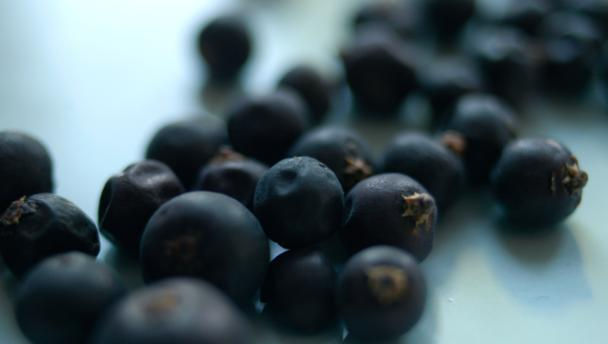For the Jennys - juniper
- rosemarydearman1
- Sep 14, 2019
- 4 min read
"Crush a juniper berry between your fingers and its clean, resinous smell perks up a dull brain as effectively as a two-shot espresso." Hugh Fearnley-Whittingstall

I have just three loyal and regular readers of this blog, and I am eternally grateful to them for their dedication to my ramblings. And to continue the coincidence theme of the moment - they are all called Jenny. Two Jennifers and a Jeannette. So I thought I would ramble around juniper berries and the names.
I first came across juniper berries in Elizabeth David's French Provincial Cooking from which I cooked many recipes back in my experiment days of early marriage. I remember very clearly that several (I thought) of her pork recipes included juniper - also her choucroute recipe. Indeed for a while there I thought it turned up in very many of her recipes. Of course, now I come to look at that book I see there are just two pork recipes - Côtes de porc en sanglier (Pork chops to taste like wild boar) and Terriné de porc (Pork chops baked with potatoes). There are probably others in her other books and she definitely uses it in her Terrine de campagne recipe. Anyway, the point is that I had never heard of juniper berries, and I now wonder where I found them. But Elizabeth David herself recognised this ignorance:
"The appearance of juniper berries in a list of ingredients often puzzles English people, which is odd considering that they constitute one of the main flavouring agents of gin, which gets its name from the Latin Ginepro, and juniper grows wild on the hills in many parts of England. At one time juniper berries were commonly used in England in the spicing of beef and hams."
I gather that the wild juniper plants of England have now been recognised as endangered, but I imagine that they must be grown commercially somewhere - for the gin. It's a type of cypress and the berries only appear every other year. But I think I have talked about that before when I 'did' gin.
It's still a little tricky to find juniper berries in the shops here. Sometimes you have to go to a delicatessen to find them.
You only need a few berries - they are quite strongly flavoured - and they need to be crushed before use - easy to do as they are soft.
Their most common uses are with various types of game - and stronger flavoured meats - venison is one of them. Of Jamie Oliver's four recipes three of them are for venison. Nigel Slater seems to favour rabbit. And they are often used in terrines and pâtés.
Why is this? Well according to Yotam Ottolenghi, a cook called Niki Segnit describes them as having, "the flavours of a country estate" and if you think 'country estate' I guess you inevitably think game. Strong flavoured meats, need strong flavoured accompaniments and "boldly bracing, ear-nose-and-throat-clearing juniper", according to Hugh Fearnley- Whittingstall is the perfect match.
I looked for a few tempting, doable and slightly different recipes and found the following: (top to bottom, left to right) Rhubarb, gin and juniper cake, Beef stew with pale ale, juniper and prunes (both from Yotam Ottolenghi, (he also had a lemon and juniper marmalade), Potted pork with juniper and thyme with a marmalade of apples raisins and shallots (from Delia), Cranberry focaccia from Nigel Slater, (he also has several other recipes), Chicken with rosemary and juniper from Hugh Fearnley-Whittingstall, who also had a recipe for potatoes and celeriac and one for rabbit, and finally Donna Hay with Tarragon and juniper oil confit trout (she also has glazes for salmon and ham).

No not finally - for Jamie Oliver also has a rather splendid looking drink - a cocktail - Berry and rosemary juniper gin fizz which he recommends for Christmas. Indeed it was surprising how many recipes I found that seemed to have a connection to Christmas.
There are, of course, tons of other recipes out there to choose from. This is just a sample from my favourite and most accessible cooks.
But back to the plant. It is also a medicinal plant of course. Some of this stems from the legend that baby Jesus was hidden under a juniper tree by his parents when they were fleeing to Egypt. Which gave it a reputation for protection - and also chastity.
"In the middle ages, boughs of prickly juniper were believed to offer protection from witches and serpents, while its pungent smoke has been used for the purification of everything from temples to barns, and to ward off the plague." Hugh Fearnley-Whittingstall.

I must admit I always thought that the name of Jennifer came from the original Latin for juniper - ginepro. But Wikipedia claims that it comes from the old English, Jenefer, Genifer and jinifer which led to Guinevere, Gwenhwyfar and Gwenore. And incidentally all of those mean 'white wave'. On the right is Guinevere as painted by William Morris. But another artist - Leonardo da Vinci no less, painted a beautiful portrait of Ginevra da Binci - with a symbolic juniper tree behind her to represent her chastity. So obviously he thought that the name Ginevra - very similar to Genifer - came from the Latin source. The beautiful painting is shown below. Anyway - my Jennifers - choose whichever origin you prefer.

Now Jeanette is a whole different story I guess. But maybe not a foodie one.
Thank you Jennys.
























Comments